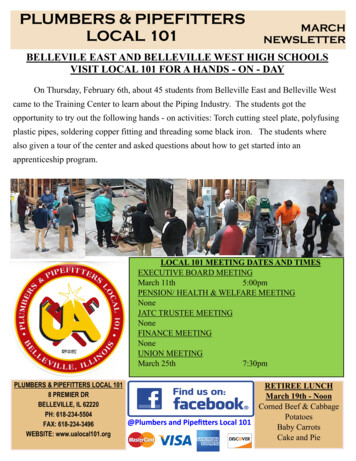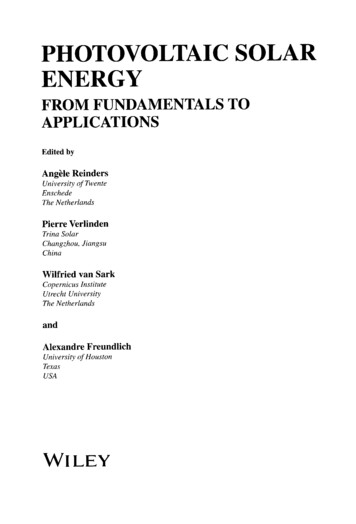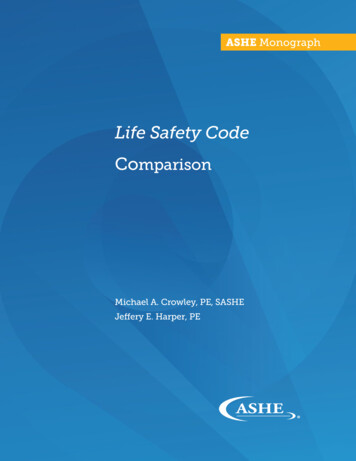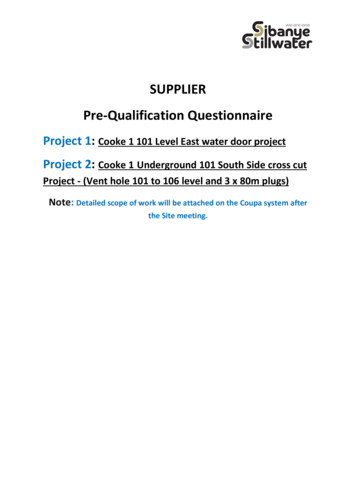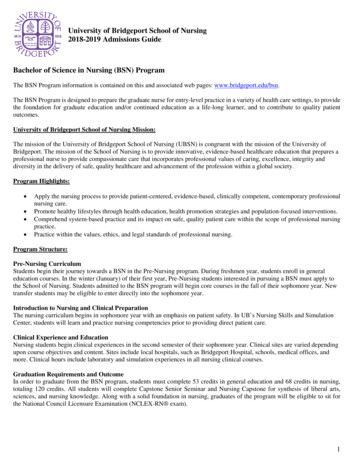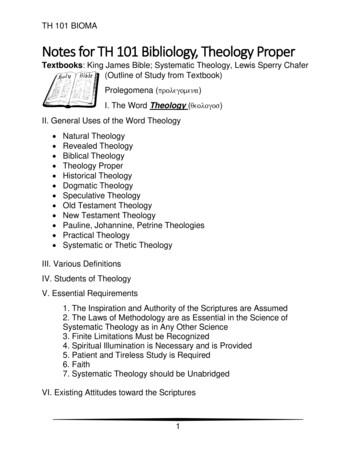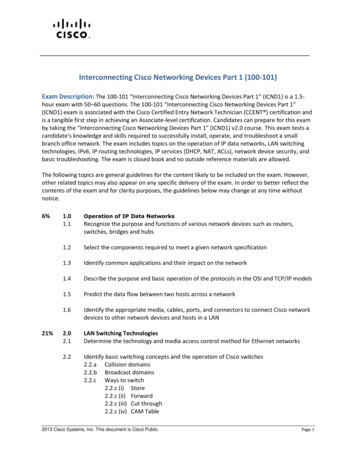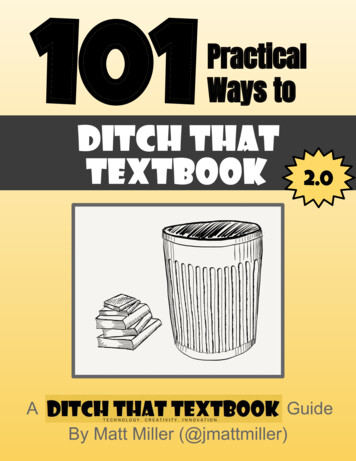
Transcription
101PracticalWays to2.0AGuideBy Matt Miller (@jmattmiller)
Your one-stop shopfor textbook ditching.If you’re like me, you’re CONSTANTLY on thelook-out for a great new idea for teaching. Theplug-and-play ideas are the best something quickthat you can apply to class tomorrow.If that’s music to your ears, you’re in the rightplace.Before you are more than 100 of the best ideasI’ve gathered in hundreds of blog posts in more thanfive years. I focused on finding the ones that canbe implemented into the classroom quickest hence the “practical ways” title.Each entry in this ebook includes a quickexplanation of a textbook-ditching idea. Clickthe blue link to see a blog post with furtherexplanation and other ideas.If you’re stumped or have questions aboutanything in this book, feel free to contact me atmatt@DitchThatTextbook.com or on Twitter at@jmattmiller. If I don’t know the answer, I knowlots of people who might!Ditching yourtextbook canbequite aprocess.Here, you’ll findideas you canimplement rightaway,savingyoutime.
1. Use icons from The Noun Projectto add a layer of visual learning.Images are powerful and brainfriendly. Adding visuals toinstruction and to products oflearning can help learning sticklong-term.2.3.Add royalty-free photos withUnsplash add-on for GoogleSlides. Students can illustratepresentations they do for class withUnsplash photos. (So can teachers!)Unsplash photos can illustratestories students write slide by slidein Google Slides.Save yourself (and yourstudents) time with voicetyping. We can talk more thanthree times faster than we cantype. With dictation tools at ourdisposal, we can get done withemails and document creationmuch faster.4.5.Do brain-friendly visualnotetaking. Our classes are oftenfilled with words, but our brains dotheir thinking in pictures. Convertwords to images to make itmemorable.Get on Twitter! Getting connectedprofessionally on Twitter was thesingle most important, mostpowerful thing I ever did as aneducator. Here are 50 people and#hashtags you must check out onTwitter.
6.7.Create instructional videos.Record short videos for yourstudents that they can watch later(or at home with parents whenthey’re struggling to complete anassignment).Avoid naughty nicknames inKahoot! with the namegenerator. Let Kahoot! pick yourstudents’nicknames forthem. Here arefour other thingsyou might notknow aboutKahoot!10.8.9.Learn languages online at yourpace. Duolingo teaches students aforeign language through quick,progressive questions. It tracksprogress, too. Think Rosetta Stonefor free!Tweet for someone. What wouldhappen if a character tweetedabout an event in the story? Usethis Google Slides template.Use picture books to teachabout digital citizenship.Teaching digital citizenship in a meaningful way can be daunting. Using picture books canillustrate important concepts beautifully. Here are some suggestions.
11.12.13.14.Bring Family Feud to class orprofessional development. Grabsome data or gather some with asurvey. Then turn it into a funFamily Feud experience. It’llsupercharge a class or a staffmeeting!Use paper and digital tools. Ourdigital stuff is searchable. We cancreate and collaborate withdigital. But paper is a viableoption, too. They can bothco-exist. Find your best blend ofusing paper and being digital inthe classroom.Find quality content online. Youdon’t always have to create it!Find content at TED Talks, SASPathways, Khan Academy andNBC Learn.Add images to Google Slidesautomatically with DriveSlides.Make creating presentations withimages super easy. It does all thephoto uploading, adding andsizing for you.15.16.17.18.Check out the Gooogle TeacherTribe Podcast. Stay up to datewith all things in GSuite andGoogle toolsto better useGoogle in theclassroom.Listen to StartEdUp podcast:Better prepare students for astart-up, entrepreneur-drivenworld by listening to this newpodcast thatChallengesTeachers’mindsets andequip them toPreparestudents forthe future.Try our genius hour in yourclass! Listen up to professionalinnovator teacher DonWettrick in how tomake geniushour work in yourclass.Create BookSnaps of whatyou’re reading. In BookSnaps,students find a passage from abook they’re reading thatresonates with them. They snap apicture of it and annotate on it,underlining and adding textreflections and including funthings like emojis and Bitmojis.Check out #booksnaps.
19. Use Google Drawings to makeinteractive graphic organizers.Create Venn diagrams,fishbone diagrams andmore. Students canedit them to add allthe necessary detailsand turn them in. Findmore than 15 pre-madegraphic organizers atthis blog post.20.21.Motivate differently. Intrinsicmotivation is powerful. Students are attheir best when given autonomy(directing themselves), mastery (gettingbetter at something that matters) andpurpose (working in service of somethingbigger than themselves).Make an e-book from survey data.Gather ideas with a Google Forms surveyand turn it into an e-book in a few steps.Make a book of class journal entries,favorite summer activities or lab results.24.22.23.Give students opportunities tocreate visual notes instead oftraditional ones. Many studentsprocess visual ideas better thantext-based ones. Embrace that byencouraging visual notetaking,either on paper or withan app like Paper byFiftyThree.Harness the power of retrieval.Imagine student retentionimproving, of less need forre-teaching if we encourage it as astudy strategy to students.Try creative alternatives to research reports and papers. I thinkit’s time that we turn research reports and papers on their heads. Letthe students create a final product that is relevant and they areexcited to share.
100.100.28.29.Using Padlet100. in class25.26.27.Document field trips.Add pictures of trips toa Padlet wall using thecamera on your device— or on studentdevices. If you haveaccess to wi-fi orcellular data, uploadthose photos on thefly. Give parents thelink before leaving andthey’ll be able to seeupdates instantlyduring the day!Create and share visual storiesusing Sutori. Student-centeredlearning is at the heart of Sutori, atool that lets students andteachers create scrolling,timeline-style multimediawebpages they call “stories”.Write emoji poetry or an emojiresponse. Brevity is an importantskill in writing. Instead ofencouraging students to write toa minimum number of words, let’stry constraining them to fewerwords — and turn them intoemojis!Help students getacquainted. Studentscan create anintroductory Padlet atthe beginning of theschool year showingthings aboutthemselves. They couldrevisit it at the end ofthe year to see if it’schanged.100.30.31.Create a livingwebquest withPadlet. Staticwebquests aren’t muchfun. Letting studentsadd their own linksand questions can addengagement andpersonalization. Createa board on Padletwhere students canadd the content theychoose.Dig into fascinating writingprompts. Need some new ideasto get students thinking — andthen writing? Write About has atreasure trove of creative,thought-provoking writingprompts atwww.writeabout.com/ideas.Provide lightning-quick feedbackstudents can REALLY use.Students crave feedback, but it hasto be timely to matter. Here aresome strategies for feedbackstudents will WANT to read.
32.34.36.37.Go beyond review with theBlind Kahoot! Use it as a way toteach. It’s a way of leadingstudents down a path of curiosity,understanding and reinforcementto learn a new concept.Create a parent portal. This is aneasy way to keep parents in theloop with what’s happening in theclassroom. Create a website withall the info parents want. Makesure to update it regularly to givethem a reason to keep comingback!Discuss an article digitallywith Hypothes.is. Hypothes.islets us share an article withstudents and start a digitaldiscussion there with digitalhighlights and sticky notes.Raid the supply closet. Thethings you may have layingaround the classroom may bethe keys to unlocking someexciting, engaging learningactivities. Check out this e-bookfor 22 pages of creative usesfor common classroom items.33.35.38.39.Let students create Kahoot!games for higher-order thinking.To write solid questions andanswers, students mustunderstand their content. Letthem write Kahoot! review gamesas an assignment.Get parents on board with yourbig changes. What would it looklike if we had them as advocatesat home, cheering their children’sprogress and supporting ourshared academic goals for theirkid?Try “hyper-annotating”documents. Students can mark updocuments. But how can wetransform that activity intosomething bigger?Hyper-annotation learn allabout it!Leveling activities —By usingGoogle Classroom’s newdifferentiation and groupingfeature, you can differentiate anactivity by creating two, three orfour versions of it. Assign togroups as needed.
40.41.42.43.Make slide presentationsinteractive with Pear Deck. Getstudents engaged in new materialby adding hands-on slides they caninteract with. Here are 20 ways touse Pear Deck.Use the Shutterstock add-on. It isa great photo editor with some nicetools that don’t exist in GoogleSlides including addinginstagram-like filters and emojis.Turn statistics into a visual aid— Using Google MyMaps, youcan add statistics to thedescription and color code thestats to visualize the data.Add a “C” to refresh oldactivities. Take your currentactivity as it is. Find one of thefour C's -- creativity, collaboration,communication and criticalthinking. Find a way to add it toyour activity. You may besurprised at the new spin it putson an activity you've done for along time.44.45.46.47.Do a shared mind mapbrainstorm with AWWApp.Students can interact in a sharedwhiteboard in AWWApp(awwapp.com).This is a really easy,collaborative way for students tosketch out and share their ideas.Be a maverick teacher! Safeteaching is risky teaching. Risky isletting kids breeze by with a lot ofactivity that doesn’t actuallyproduce any learning. That’s risky.We need the teacher who willreject the status quo if it isn’tproducing results.Make Lessons Hands on! Somany of us are tactile learners.We don’t want to be told how it’sdone. We want to do it. It’s likethat for adults and for kids.Create comic strips out of newcontent. Students can useimages, speech bubbles and moreto create fun, engaging comicstrips to demonstrate learning.
48.49.50.51.Make photos interactive withannotation in Google Drawings. Addarrows, notes, circles and more to tagphotos and make them learningexperiences. Bring the photo into ablank Google Drawing and then starttagging it!Engage in a cultural exchange. Pairup with a classroom in a differentcountry. Share ideas and askquestions via video chat (Skype,Google Hangout, FaceTime). Writeand engage withshared GoogleDocuments. Broaderworld views will result.Timeline projects. Timelines givestudents a great visual understandingof how events happened over time.There’s a reason they’ve been a staplein the classroom for a while. Increasedepth of knowledge with a twist onthe traditional.Assign challenges instead ofmath homework. Students cando powerful learning outside ofclass. But how do we keep it frombeing “traditional homework”? Theanswer may be challenges andpuzzles. Check out John Stevens’swebsite tabletalkmath.com formore ideas.52.53.54.55.Make rockin’ presentations. Slidepresentations don’t have to be dull.Mind maps, Creative Commonsimages, screenshots, collaborationand more can bring them to lifeand get viewers engaged.Create media-rich, interactivemaps for deeper learning onGoogle MyMaps.Google MyMapslets students create maps withcustom-pinned location. The magic,though, is in what you put in thosepins.Ask a character/historic figure aquestion. What if students couldask someone they’re studying aquestion? Students could ask onequestion with one answer from thecharacter/historic figure, or theycould do a back-and-forth withseveral photos.Use TodaysMeet. TodaysMeet isan easy-to-use, versatile digitaltool. It can enhance discussions,provide a place for ideas and more.
Websites: A home for your stuff56.57.Create project websites, not justprojects. Do more than share withthe class. By using a Google Site,students can showcase their hardwork to a larger audience — anyonethey share the link with to theirwebsite.Embedded Quizlet flashcards.I’m a huge fan of Quizlet, an onlineflashcard site. Quickly create a setof Quizlet flashcards. Embed aninteractive version of it on yoursite. Students can flip throughtheir terms without having to leaveyour site.58.59.Screencast sub lesson plans. If you’veever left lesson plans for substituteteachers, you’ve probably felt thefrustration of students not following yourinstructions specifically as you describedthem. Make sub plans crystal clear with ascreencast video.Create a video course/repositorywebsite. Consider creating a website withlots of embedded videos that cover thetopics students may need a refresher on. Ifthey need a reminder, you can easily say,“Go watch that quick video on thewebsite.”Flickr / Yamil Gonzales60.Write blackout poetry. Have thestudents take a picture or screenshotof an article. Paste that image intoGoogle Drawings/Slides andblackout everything except thewords chosen for the poem.61.Add speech bubbles to a historicphoto. Add a new twist to a lessonby letting students speak — or think— for the characters.
62.63.64.Use digital flashcards efficiently. When students use digital flashcard tools like Quizlet(or regular index card flashcards), they often drop cards out of their decks too quickly. Theythink they have memorized them. Research shows gains when they practice them all threetimes before dropping any from the deck.Spaced practice is strong practice. Spacing out repeated encounters with material overtime produces superior long-term learning. Creating reminders with Google Calendar,Boomerang or Remind can bring material back to students’ minds at predetermined times,creating the spaced practice the brain desires.Improve recall with brain dumps. For long-term memory, brain research encourages this:1. Paus your lesson, lecture or activity. 2. Ask students to write down everything they canremember. 3. Continue your lesson, lecture and activity. Do this digitally with Google Docsor Google Keep, on paper, or on a sketching app like the Paper app by FiftyThree.
Connect your class digitally68.65.Take a virtual field trip. Virtual fieldtrips let you take students all overthe world to unique experiences theywouldn’t get otherwise.Mystery Skype. This activity is thegateway to so much more. Pair upwith another class and ask yes/noquestions to guess where in theworld that class is.66.67.Invite guest speakers. Hearing aguest doesn’t require a field trip ortravel expenses. Find someone tospeak to your class and invitehim/her to use Google Hangouts orSkype so students can see and hearhim/her.Presenting to both groups. Ifstudents do presentations, why limittheir audience to just your class?Connect with another class andpresent to each other. Ask forcomments, questions, praise and/orconstructive feedback.69.70.Collaborative art/writing – It’samazing what students and classescan create together. Have one start astory or a work of art and pass it tothe other class virtually. Let the otherclass add to it and pass it back. Oncethey’re finished, they will havecreated something both will takepride in!Try author chats. If you’ve read abook and the author is alive, why notreach out to see if he/she wants toSkype with your class? Manychildren’s authors thrive on talkingto the kids that read their books!
71.72.73.74.Analyze student writing in asnap. Copy student writing intoHemingway App(hemingwayapp.com) and itanalyzes grade level,paragraph/sentence/word/character count, hard-to-read sentencesand more.Let students share their voice toreflect digitally. Learning is limitedwhen students can't put it in thebig picture. Let studentsreflect.One of my favorite digitaltools to empower students to dothat is Flipgrid.Rotating activities with GoogleClassroom— If you have stations ora set of activities groups of studentswill do over a period of days orweeks, keep assignments simple byassigning just the activity each groupis working on.Remix your old lessons! Considerbuilding lessons that utilizetechnology through this framework.It may give you the inspiration toteach a lesson you’ve done foryears in a different way.75.76.77.78.Exploring the Explore tool. TheExplore tool in Google can reducethe time you and your studentslose doing mundane tasks. It willfind info and images as well as agreat design for slidepresentations. That means moretime for learning!Draw with your finger (or acomputer touchpad). Havingstudents draw what’s in theirbrains — or how they understanda concept — can be a quick andeasy way to get them on track forthe day. Formative makes thiseasy AND digital with its “ShowYour Work” questions.Reduce your reliance onhomework. Focus on improvingthe time you have in classtogether with your studentsinstead of assigning more/betterhomework. Here are somestrategies for reducing yourreliance on homework.DITCH. Different. Innovative.Tech-Laden.Creative. Hands on.Looking for the secret sauce thathelps you create wildly engaginglessons? The five parts of thisframework have helped me.
Flickr / Danny Sullivan79.80.81.Creating eye-popping infographicswith Google Drawings. They’reeye-catching. They summarizeinformation succinctly. They’re veryvisual, whether you’re viewing on apage or a printed version hung on awall. They’re easy to share.Shared slide presentations.GoogleSlides do not have to be used just todo presentations in front of theclass! Use a shared Google slidepresentation to start class off with aquestion. Each student has their ownslide to respond.Google’s buried treasure. With allthe Google tools out there, it’s easyfor some to slip through the cracks.Here are some lesser-known Googletools that can have an impact.82.83.84.Write Google-infused researchpapers. Use this workflow tostreamline writing a research paper.Thanks to Google and several of itstools, you do that academic workmore effectively and efficientlyCreate “Choose Your OwnAdventure” stories. Rememberthose stories where you pick whatthe characters in the book do, thenturn to a specific page to see whathappens? Students can create themusing Google Forms. Click here tosee how.Keep: Digital sticky notes. GoogleKeep is like a bulletin board you cankeep with you wherever you go. It’sperfect for organizing ideas orquickly jotting down inspiration.
85.86.87.88.Creating moveable digitalactivities with Google Drawings Slides. Moveable activity boards.Virtual manipulatives. Digitalinteractive activities. Whateverthey’re called, Google Slides andGoogle Drawings were made forcreating themGive the old poster project a newtwist. Create them in GoogleDrawings instead. You can addclickable links to these posters. Linkto video, audio, images andinteractive websites to make yourposter an interactive, multimediaone.Get inspiration in unlikely places.Sometimes, new ideas for a lessoncan be right in front of you or youneed some new scenery to generateideas. I used a trip to Dallas togenerate some new classroom ideasand came up with a bunch!Put new learning in motion!Google Slides (or PowerPoint orany presentation slide tool) can beturned into a simple stop-motionanimation tool. They’re fun forstudents to create and share withothers!89.90.91.92.5 minutes of inspiration everyschool day: The Ditch ThatTextbook Podcast. Listen to thispodcast to get some new ideas ora jump-start to yourday. The episodesare quick for yourcommute to orfrom school!Make sure you get the rightdata in Google Forms. Datavalidation can be your best friendwhen using Google Forms. Itmakes sure the data entered inthe Google Forms survey is thetype you need, and if it’s not, itdisplays an error message.Pin important locations in an areabeing studied. Studying a certainlocation? Before digging into yourcontent, have students do somepreliminary Internet research andcreate a Google MyMap with theirfindings. They’ll be better preparedfor your unit of study!Create animated GIFs. Thesefun, moving images are all oversocial media. They’re short andcan capture an idea in an instant.Google Photos will create ananimated GIF automatically forstudents.
Catch the Flipgrid Fever!Flipgrid is a classroom videoplatform. Teachers ask a questionor create a prompt. Then, studentscan respond to it with a shortvideo clip that they shoot on theirdevices. Teachers and students allover the world are findinginnovative ways to give students avoice with this tool.93.94.95.30 second book talk challenge.Have your students share abouttheir favorite book in 30 seconds orless. Check out this example.Put a spin on student of theweek. Have each student record avideo sharing why that student ofthe week is special. Students willenjoy watching video messagesfrom their classmates sharing whythey are a valued member of theirclassroom community.Exit tickets get a makeover. Postthe question “What did you learntoday?” or better yet ask yourstudents “What did you createtoday?” for the students to answerbefore leaving class.96.97.98.Debate a topic! Add a Flipgrid tothe share section of this “GreatDebate” HyperDoc by RaynaFreedman to get your studentsdebating.Reading response goes digital.After your class reads an article,chapter or book have them respondto a question about their reading.Take the conversation further byhaving students comment on eachother’s responses.Show what you know! Choice andvoice are so important for gettingstudents to share their knowledgewith us. What better way to do thatthen to add Flipgrid as an option ina Show What You Know BINGOboard?
Creating with videoFlickr / Kevin Dooley99.Record whiteboard animations.Those videos with a hand furiouslyillustrating on a whiteboard aren’tthat hard to create. Turn studentsloose and let them create these funvideos as a project.101.100.Create Netflix-style learningwith screencast. Whenstudents have createdscreencast videos and they lookback through their work, it’s likeNetflix for learning!Use a time-lapse video. Time-lapse and slow motionvideos give a unique perspective into motion. Use a freeapp like Hyperlapse and Lapse It to create time-lapsevideos or a slow-motion app like Slow Motion Video FX.Looking for more ideas?Check out the DitchThat Textbook blog!Head over toDitchThatTextbook.comto browse articles,search for specifictopics or check out thedifferent pagesavailable. You’ll findnew articles about awide variety of topicsrelated to creativity,technology andinnovation.
About the authorMatt Miller is an author, speaker and blogger from West Central Indiana. He believes inmaking teaching relevant to students and their future through technology, creativity andinnovation. He’s a Google Certified Innovator and a 10 year classroom veteran. Mattcreated and writes at the Ditch That Textbook blog, which promotes less reliance on thetextbook with an emphasis on creative teaching.Connect with Matt —E-mail: matt@DitchThatTextbook.comTwitter: @jmattmillerYouTube: youtube.com/ditchthattextbookPinterest: pinterest.com/DitchThatTxtFacebook: facebook.com/DitchThatTextbookHire Matt to presentMatt is an experienced professional development speaker. He has presented at dozensof conferences, schools and school districts to thousands of educators. His wide rangeof topics span Google Apps, intentional tech use, blogging, global connections andbeyond. His participants appreciate his practical, hands-on approach and hisperspective as a practicing teacher.Matt can present at your school, district or event. He can provide full-day professionaldevelopment, keynote speeches and concurrent conference sessions.See DitchThatTextbook.com/conferences for more info or e-mail Matt atmatt@DitchThatTextbook.com to discuss pricing and availability.
hence the “practical ways” title. Each entry in this ebook includes a quick explanation of a textbook-ditching idea. Click the blue link to see a blog post with further explanation and other ideas. If you’re stumped or have questions about anything in this book, feel free to cont
